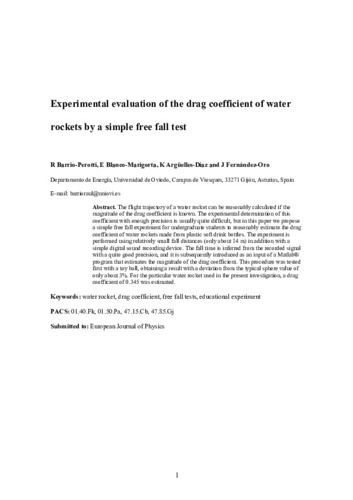Experimental evaluation of the drag coefficient of water rockets by a simple free-fall test
Publication date:
Publisher version:
Citación:
Descripción física:
Abstract:
The flight trajectory of a water rocket can be reasonably calculated if the magnitude of the drag coefficient is known. The experimental determination of this coefficient with enough precision is usually quite difficult, but in this paper we propose a simple free fall experiment for undergraduate students to reasonably estimate the drag coefficient of water rockets made from plastic soft drink bottles. The experiment is performed using relatively small fall distances (only about 14 m) in addition with a simple digital sound recording device. The fall time is inferred from the recorded signal with a quite good precision, and it is subsequently introduced as an input of a Matlab® program that estimates the magnitude of the drag coefficient. This procedure was tested first with a toy ball, obtaining a result with a deviation from the typical sphere value of only about 3%. For the particular water rocket used in the present investigation, a drag coefficient of 0.345 was estimated.
The flight trajectory of a water rocket can be reasonably calculated if the magnitude of the drag coefficient is known. The experimental determination of this coefficient with enough precision is usually quite difficult, but in this paper we propose a simple free fall experiment for undergraduate students to reasonably estimate the drag coefficient of water rockets made from plastic soft drink bottles. The experiment is performed using relatively small fall distances (only about 14 m) in addition with a simple digital sound recording device. The fall time is inferred from the recorded signal with a quite good precision, and it is subsequently introduced as an input of a Matlab® program that estimates the magnitude of the drag coefficient. This procedure was tested first with a toy ball, obtaining a result with a deviation from the typical sphere value of only about 3%. For the particular water rocket used in the present investigation, a drag coefficient of 0.345 was estimated.
ISSN:
Identificador local:
20090169
Patrocinado por:
The authors gratefully acknowledge the financial support of the Gobierno del Principado de Asturias (Plan de Ciencia, Tecnología e Innovación 2006-09).
Files in this item





